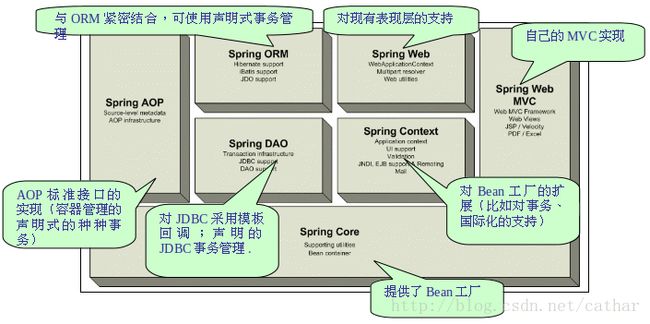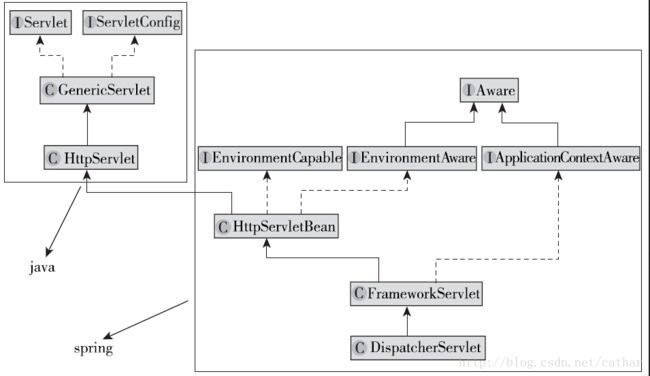Spring、SpringMVC及web容器的Context上下文
Spring 功能与结构
基于Java Beans的配置管理,采用IOC的原理,特别是对依赖注入技术的使用。这些都用来减少各组件间对实施细则的相互依赖性。
一个核心的,全局适用的Bean工厂。
一个一般抽象化的层面来管理数据库间的数据处理。
建立在框架内的,对Java数据处理API和单独的JDBC数据源的一般性策略。因此,在数据处理支持上对Java企业版本环境的依赖性得以消除。
和一些可持续性的框架,如Hibernate,JDO,MyBatis和db4o的整合。
Web应用中的MVC框架,基于核心的Spring功能,支持多种产生视图的技术,包括JSP,FreeMarker,Velocity,Tiles,iText,和POI。
大量的AOP框架以提供诸如数据处理管理的服务。同IOC的功能一样,目的是提高系统的模块化程度
Spring框架旨在分离体系结构的层次,由7个定义良好的模块组成,因此每一层都可以修改而不会影响到其它层。每一层都不知道其上层的关注点;就其可能而言,只对所紧挨的下一层有依赖。层与层之间的依赖通常是以接口的形式表现,以确保其耦合尽可能松散。Spring模块构建在核心容器之上,核心容器定义了创建、配置和管理Bean的方式。
参考:https://my.oschina.net/xianggao/blog/417983
Spring java 工程
定义Bean
package com.king.helloworld.bean;
public class HelloWorld {
private String name;
public void setName(String name) {
this.name = name;
}
public void hello() {
System.out.println("Hello, " + name);
}
}配置ApplicationContext.xml
<beans xmlns="http://www.springframework.org/schema/beans"
xmlns:xsi="http://www.w3.org/2001/XMLSchema-instance"
xsi:schemaLocation="http://www.springframework.org/schema/beans
http://www.springframework.org/schema/beans/spring-beans.xsd">
<bean id="helloWorld" class="com.king.helloworld.bean.HelloWorld">
<property name="name" value="Tao Bangren"/>
bean>
beans>运行Main
public class Main {
public static void main (String [] args) {
ApplicationContext context = new ClassPathXmlApplicationContext("applicationContext-bean.xml");
HelloWorld helloWorld = (HelloWorld) context.getBean("helloWorld");
helloWorld.hello();
}
}SpringMVC 在WEB容器中的启动过程与web.xml配置解析
- web应用部署在web容器中,web容器(如tomcat)提供其一个全局的上下文环境,这个上下文就是 ServletContext,其为后面的spring IoC容器提供宿主环境;
- 在web.xml中会提供有contextLoaderListener。在web容器启动时,会触发容器初始化事件,此时contextLoaderListener会监听到这个事件,其contextInitialized方法会被调用,在这个方法中,spring会初始化一个启动上下文,这个上下文被称为根上下文,即WebApplicationContext,该接口类实际的实现类是XmlWebApplicationContext,即spring的IoC容器,其对应的Bean定义的配置由web.xml中的context-param标签指定。在此IoC容器初始化完毕后,spring以WebApplicationContext.ROOTWEBAPPLICATIONCONTEXTATTRIBUTE为属性Key,将其存储到ServletContext中,便于获取;
//**************************************************************
//实现ServletListener接口的类初始化方法中接收到通知事件
//**************************************************************
public void contextInitialized(ServletContextEvent event) {
this.contextLoader = createContextLoader();
this.contextLoader.initWebApplicationContext(event.getServletContext());
}
protected ContextLoader createContextLoader() {
return new ContextLoader();
}
//**************************************************************
//initWebApplicationContext(ContextLoaderListener中创建 context)
//**************************************************************
public WebApplicationContext initWebApplicationContext(ServletContext servletContext) {
//PS : ROOT_WEB_APPLICATION_CONTEXT_ATTRIBUTE=WebApplicationContext.class.getName() + ".ROOT" 根上下文的名称
//PS : 默认情况下,配置文件的位置和名称是: DEFAULT_CONFIG_LOCATION = "/WEB-INF/applicationContext.xml"
//在整个web应用中,只能有一个根上下文
if (servletContext.getAttribute(WebApplicationContext.ROOT_WEB_APPLICATION_CONTEXT_ATTRIBUTE) != null) {
throw new IllegalStateException("Cannot initialize context because there is already a root application context present - " + "check whether you have multiple ContextLoader* definitions in your web.xml!");
}
Log logger = LogFactory.getLog(ContextLoader.class);
servletContext.log("Initializing Spring root WebApplicationContext");
if (logger.isInfoEnabled()) {
logger.info("Root WebApplicationContext: initialization started");
}
long startTime = System.currentTimeMillis();
try {
// Store context in local instance variable, to guarantee that
// it is available on ServletContext shutdown.
if (this.context == null) {
// *****************************************************
//在这里执行了创建WebApplicationContext的操作,后文有介绍
//******************************************************
this.context = createWebApplicationContext(servletContext);
}
if (this.context instanceof ConfigurableWebApplicationContext) {
ConfigurableWebApplicationContext cwac = (ConfigurableWebApplicationContext) this.context;
if (!cwac.isActive()) {
// The context has not yet been refreshed -> provide services such as setting the parent context, setting the application context id, etc
if (cwac.getParent() == null) {
// The context instance was injected without an explicit parent -> determine parent for root web application context, if any.
ApplicationContext parent = loadParentContext(servletContext);
cwac.setParent(parent);
}
configureAndRefreshWebApplicationContext(cwac, servletContext);
}
}
// PS: 将根上下文放置在servletContext中
servletContext.setAttribute(WebApplicationContext.ROOT_WEB_APPLICATION_CONTEXT_ATTRIBUTE, this.context);
ClassLoader ccl = Thread.currentThread().getContextClassLoader();
if (ccl == ContextLoader.class.getClassLoader()) {
currentContext = this.context;
} else if (ccl != null) {
currentContextPerThread.put(ccl, this.context);
}
if (logger.isDebugEnabled()) {
logger.debug("Published root WebApplicationContext as ServletContext attribute with name [" +
WebApplicationContext.ROOT_WEB_APPLICATION_CONTEXT_ATTRIBUTE + "]");
}
if (logger.isInfoEnabled()) {
long elapsedTime = System.currentTimeMillis() - startTime;
logger.info("Root WebApplicationContext: initialization completed in " + elapsedTime + " ms");
}
return this.context;
} catch (RuntimeException ex) {
logger.error("Context initialization failed", ex);
servletContext.setAttribute(WebApplicationContext.ROOT_WEB_APPLICATION_CONTEXT_ATTRIBUTE, ex);
throw ex;
} catch (Error err) {
logger.error("Context initialization failed", err);
servletContext.setAttribute(WebApplicationContext.ROOT_WEB_APPLICATION_CONTEXT_ATTRIBUTE, err);
throw err;
}
}
//**************************************************************
//创建 WebApplicationContext 对象
//**************************************************************
protected WebApplicationContext createWebApplicationContext(ServletContext sc, ApplicationContext parent) {
//根据web.xml中的配置决定使用何种WebApplicationContext。默认情况下使用XmlWebApplicationContext
//web.xml中相关的配置context-param的名称“contextClass”
Class contextClass = determineContextClass(sc);
if (!ConfigurableWebApplicationContext.class.isAssignableFrom(contextClass)) {
throw new ApplicationContextException("Custom context class [" + contextClass.getName() + "] is not of type [" + ConfigurableWebApplicationContext.class.getName() + "]");
}
//实例化WebApplicationContext的实现类
ConfigurableWebApplicationContext wac = (ConfigurableWebApplicationContext) BeanUtils.instantiateClass(contextClass);
// Assign the best possible id value.
if (sc.getMajorVersion() == 2 && sc.getMinorVersion() < 5) {
// Servlet <= 2.4: resort to name specified in web.xml, if any.
String servletContextName = sc.getServletContextName();
if (servletContextName != null) {
wac.setId(ConfigurableWebApplicationContext.APPLICATION_CONTEXT_ID_PREFIX + servletContextName);
} else {
wac.setId(ConfigurableWebApplicationContext.APPLICATION_CONTEXT_ID_PREFIX);
}
} else {
// Servlet 2.5's getContextPath available!
wac.setId(ConfigurableWebApplicationContext.APPLICATION_CONTEXT_ID_PREFIX + sc.getContextPath());
}
wac.setParent(parent);
wac.setServletContext(sc);
//设置spring的配置文件
wac.setConfigLocation(sc.getInitParameter(CONFIG_LOCATION_PARAM));
customizeContext(sc, wac);
//spring容器初始化
wac.refresh();
return wac;
}
//***************************************************************
//先来看一下initWebApplicationContext的实现:FrameworkServlet.java
//***************************************************************
protected WebApplicationContext initWebApplicationContext() {
//先从web容器的ServletContext中查找WebApplicationContext
WebApplicationContext wac = findWebApplicationContext();
if (wac == null) {
// No fixed context defined for this servlet - create a local one.
//从ServletContext中取得根上下文
WebApplicationContext parent = WebApplicationContextUtils.getWebApplicationContext(getServletContext());
//创建Spring MVC的上下文,并将根上下文作为起双亲上下文
wac = createWebApplicationContext(parent);
}
if (!this.refreshEventReceived) {
// Apparently not a ConfigurableApplicationContext with refresh support:
// triggering initial onRefresh manually here.
onRefresh(wac);
}
if (this.publishContext) {
// Publish the context as a servlet context attribute.
// 取得context在ServletContext中的名称
String attrName = getServletContextAttributeName();
//将Spring MVC的Context放置到ServletContext中
getServletContext().setAttribute(attrName, wac);
if (this.logger.isDebugEnabled()) {
this.logger.debug("Published WebApplicationContext of servlet '" + getServletName() + "' as ServletContext attribute with name [" + attrName + "]");
}
}
return wac;
}DispatcherServlet上下文在初始化的时会建立自己的IoC上下文,用以持有spring mvc相关bean。利用WebApplicationContext.ROOTWEBAPPLICATIONCONTEXTATTRIBUTE 从ServletContext 中 获取之前的根上下文(即WebApplicationContext)作为自己上下文的parent上下文。设置parent上下文之后,再初始化自己的上下文。在其initStrategies方法中可以看到,大概的工作就是初始化处理器映射、视图解析等。这个servlet自己持有的上下文默认实现类也是 xmlWebApplicationContext。初始化完毕后,spring以与servlet的名字相关属性Key,也将其存到 ServletContext 中供后续使用。这样每个servlet持有自己的上下文(即拥有自己独立的bean空间),同时,各servlet共享相同的bean,即根上下文(第2步中初始化的上下文)定义的bean。
通过initWebApplicationContext方法的调用,创建了DispatcherServlet对应的context,并将其放置到ServletContext中,这样就完成了在web容器中构建Spring IoC容器的过程。
<context-param>
<param-name>contextConfigLocationparam-name>
<param-value>/WEB-INF/applicationContext.xmlparam-value>
context-param>
<listener>
<listener-class>
org.springframework.web.context.ContextLoaderListener
listener-class>
listener>
<servlet>
<servlet-name>mvc-dispatcherservlet-name>
<servlet-class>
org.springframework.web.servlet.DispatcherServlet
servlet-class>
<init-param>
<param-name>contextConfigLocationparam-name>
<param-value>
/WEB-INF/mvc-servlet.xml,
classpath*:com/temp/framework/config/spring/frameworkContext.xml
param-value>
init-param>
<load-on-startup>1load-on-startup>
servlet>
<servlet-mapping>
<servlet-name>mvc-dispatcherservlet-name>
<url-pattern>/url-pattern>
servlet-mapping>span>SpringMVC 核心Servlet结构图
servletContext
web 容器提供的全局上下文环境,为后面的 Spring IOC 提供宿主环境。
ApplicationContext
继承自BeanFactory接口,除了包含BeanFactory的所有功能之外,在国际化支持、资源访问(如URL和文件)、事件传播等方面进行了良好的支持,被推荐为Java EE应用之首选,可应用在Java APP与Java Web中。
由web.xml中提供的 contextLoaderListener,在web容器启动时触发容器初始化事件,其中的 contextInitialized 方法被调用时创建的根上下文(即:WebApplicationContext.ROOT_WEB_APPLICATION_CONTEXT_ATTRIBUTE,)。采用 XmlWebApplicationContext 实现方法,作为 Spring IOC 容器,对应的 Bean 定义的配置由 web.xml 中的 context-param 标签指定。会被存储在 ServletContext 中。例如:
<listener>
<listener-class>org.springframework.web.context.ContextLoaderListenerlistener-class>
listener>
<context-param>
<param-name>contextConfigLocationparam-name>
<param-value>
/WEB-INF/spring/jdbc/spring-jdbc.xml
/WEB-INF/spring/security/spring-security-context.xml
param-value>
context-param>WebApplicationContext
获取根上下文(WebApplicationContext.ROOTWEBAPPLICATIONCONTEXTATTRIBUTE ) 作为自己上下文的parent上下文,再初始化自己持有的上下文(默认实现类也是 xmlWebApplicationContext)。之后将该上下文以key-value的方式设置在 ServletContex中,以便后续使用。至此,每个 Servlet 既有自己的上下文(即独立的bean空间),又各个 Servlet 可以共享根上下文中定义的 bean。
例如:DispatcherServlet 维持自己的 ApplicationContext,默认会读取/WEB-INFO/-servlet.xml 文件,也可以在 /WEB-INF/web.xml 中的 Servlet 模块 重新配置。例如:
<servlet>
<servlet-name>spring-mvcservlet-name>
<servlet-class>org.springframework.web.servlet.DispatcherServletservlet-class>
<init-param>
<param-name>contextConfigLocationparam-name>
<param-value>
/WEB-INF/spring/mvc/spring-mvc-servlet.xml
param-value>
init-param>
servlet>
<servlet-mapping>
<servlet-name>spring-mvcservlet-name>
<url-pattern>/admin/*url-pattern>
servlet-mapping>后两种 context 的区别与关系
- 功能而言:ContextLoaderListener中创建ApplicationContext主要用于整个Web应用程序需要共享的一些组件,不管是使用什么表现层技术,一般如DAO层、Service层Bean、数据库的ConnectionFactory等。而由DispatcherServlet创建的ApplicationContext 只加载对Spring Web MVC有效的Bean,如Controller、HandlerMapping、HandlerAdapter等等,该初始化上下文应该只加载Web相关组件。
- 范围而言:在DispatcherServlet中可以引用由ContextLoaderListener所创建的ApplicationContext,而反过来不行。
- 实现顺序:这两个ApplicationContext都是通过ServletContext的setAttribute方法放到ServletContext中的。但是,ContextLoaderListener会先于DispatcherServlet创建ApplicationContext,DispatcherServlet在创建ApplicationContext时会先找到由ContextLoaderListener所创建的ApplicationContext,再将后者的ApplicationContext作为参数传给DispatcherServlet的ApplicationContext的setParent()方法。此后,框架又会调用ServletContext的setAttribute()方法将wac加入到ServletContext中。
- 查找顺序:当Spring在执行ApplicationContext的getBean时,如果在自己context中找不到对应的bean,则会在父ApplicationContext中去找。这也解释了为什么我们可以在DispatcherServlet中获取到由ContextLoaderListener对应的ApplicationContext中的bean。
参考资料
https://my.oschina.net/xianggao/blog/523888
http://baike.baidu.com/link?url=JYiSvbiupc6jwSDffPpJuOSuJmJYCH6q17s_CndzAUE1f9xWyyaW1bt1zRrGfUVTvAPFPpsXKFO9-J_HSrl_SapvwOl5zl1zv55yzwyCBCa
http://spring.group.iteye.com/group/wiki/1225
http://stackoverflow.com/questions/600095/splitting-applicationcontext-to-multiple-files/28693991#28693991
《Servlet/JSP深入详解:基于Tomcat的Web开发》http://book.51cto.com/art/200808/85036.htm

